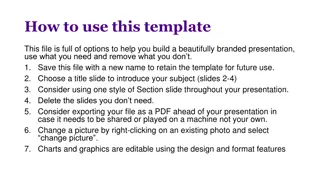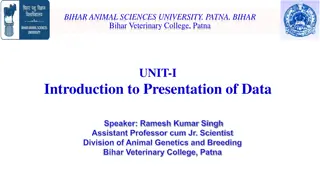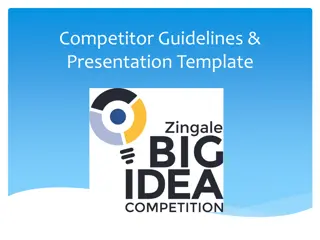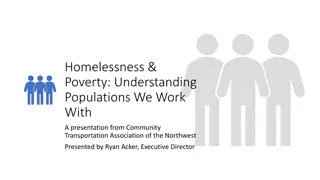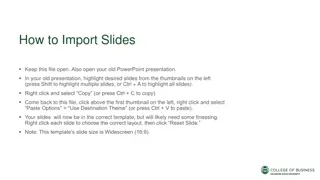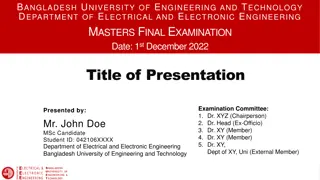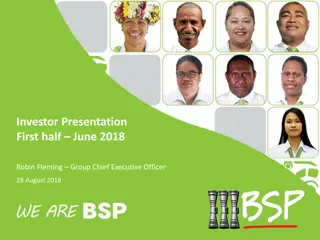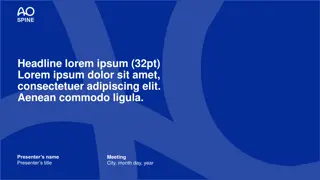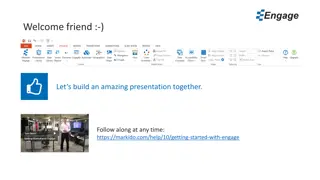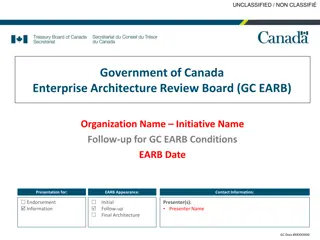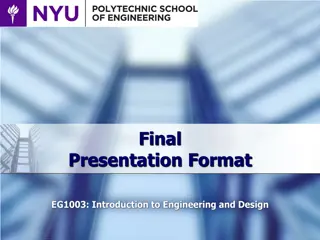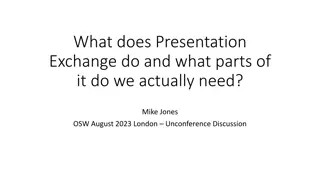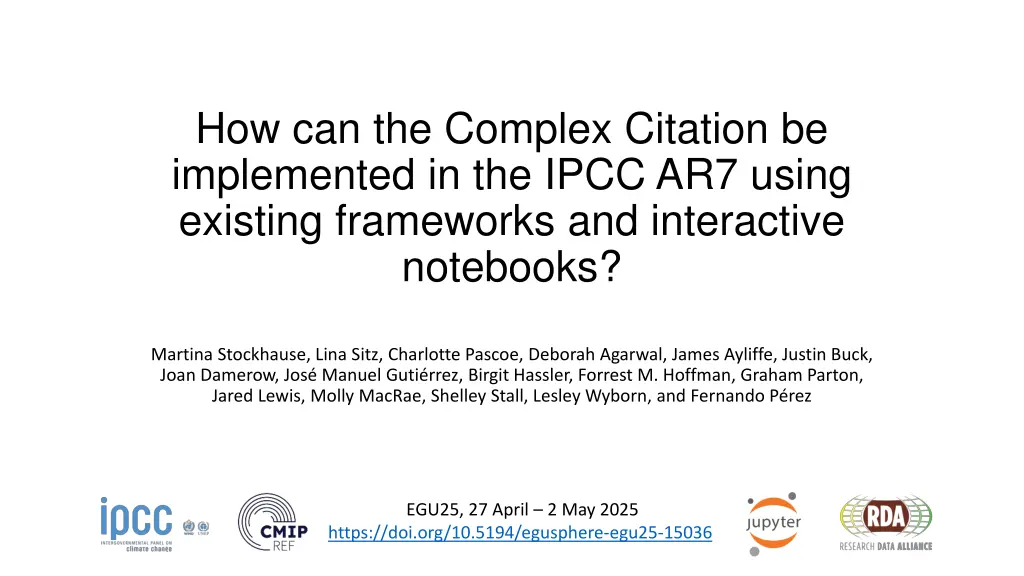
Implementing IPCC AR7 Complex Citation with Existing Frameworks
Explore the implementation of Complex Citation in IPCC AR7 using existing frameworks and interactive notebooks. Understand the importance of traceability and credit assignment in enhancing transparency and supporting authors. Learn about the FAIR data principles and recommendations for improving data traceability. Dive into the structure of the report and data, including key figures and datasets. Discover the plans for Complex Citation in IPCC AR7 as a simple and flexible solution for better traceability and credit assignment.
Download Presentation

Please find below an Image/Link to download the presentation.
The content on the website is provided AS IS for your information and personal use only. It may not be sold, licensed, or shared on other websites without obtaining consent from the author. If you encounter any issues during the download, it is possible that the publisher has removed the file from their server.
You are allowed to download the files provided on this website for personal or commercial use, subject to the condition that they are used lawfully. All files are the property of their respective owners.
The content on the website is provided AS IS for your information and personal use only. It may not be sold, licensed, or shared on other websites without obtaining consent from the author.
E N D
Presentation Transcript
How can the Complex Citation be implemented in the IPCC AR7 using existing frameworks and interactive notebooks? Martina Stockhause, Lina Sitz, Charlotte Pascoe, Deborah Agarwal, James Ayliffe, Justin Buck, Joan Damerow, Jos Manuel Guti rrez, Birgit Hassler, Forrest M. Hoffman, Graham Parton, Jared Lewis, Molly MacRae, Shelley Stall, Lesley Wyborn, and Fernando P rez EGU25, 27 April 2 May 2025 https://doi.org/10.5194/egusphere-egu25-15036 Stockhause et al., 2025, https://doi.org/10.5194/egusphere-egu25-15036
IPCCs FAIR and open data approach IPCC AR6 FAIR Guidelines enhance the transparency of IPCC s outputs: Traceability of key statements of the report by documentation of data usage in figure/table generation Credit for input data like CMIP6, created scripts, intermediate and final data Preservation of curated input data, scripts, intermediate and final data IPCC TG-Data Recommendations for AR7: Complex Citation implementation to improve traceability Better support for authors in generating the requested information References: Pirani et al. (2022) The implementation of FAIR data principles in the IPCC AR6 assessment process. https://doi.org/10.5281/zenodo.6504468 Intergovernmental Panel on Climate Change. (2023). TG-Data Recommendations for AR7 (1.0). Zenodo. https://doi.org/10.5281/zenodo.10059282 Stockhause M et al. (2024) Implementing FAIR data principles in the IPCC seventh assessment cycle: Lessons learned and future prospects. PLOS Clim 3(12): e0000533. https://doi.org/10.1371/journal.pclm.0000533 Stockhause et al., 2025, https://doi.org/10.5194/egusphere-egu25-15036
Structure of report and data DOI 17 citable parts / 13 Chapters, 514 Figures, 448 Data Figures, >172 Model Data Figures in 9 Chapters Fig. 10.21 AR6 WGI CORDEX Input Data 30 Model Exp. 129 Datasets CMIP6 Input Data 173 Model Exp. 346 Datasets HDL DOI cordex.output.EUR-11.CLMcom. CNRM-CERFACS-CNRM-CM5.historical. r1i1p1.CCLM4-8-17.v1.mon.pr.20140515 cordex.output.EUR-11. historical.CCLM4-8-17 CMIP6.HighResMIP.CMCC. CMCC-CM2-VHR4.hist-1950 CMIP6.HighResMIP.CMCC.CMCC-CM2-VHR4. hist-1950.r1i1p1f1.Amon.pr.gn.20180705 cordex.output.EUR-11.CLMcom. MOHC-HadGEM2-ES.historical. r1i1p1.CCLM4-8-17.v1.mon.tas.20150320 HDL CMIP6.HighResMIP.CMCC.CMCC-CM2-VHR4. hist-1950.r1i1p1f1.Amon.tas.gn.20180705 DOI 49 Figures, 48 Data Figures, 47 Model Data Figures Ch3 CMIP5 Input Data 145 Model Exp. 227 Datasets URL MPI-GE Input Data 2 Model Exp. 202 Datasets Fig. 3.16 Figure 10. 21 | Projected Mediterranean summer warming. cmip5.output1.IPSL. IPSL-CM5A-LR.rcp85 mpi-ge.output1.MPI-M. MPI-ESM.historical cmip5.output1.IPSL.IPSL-CM5A-LR.rcp85. mon.atmos.Amon.r1i1p1.20111103.pr mpi-ge.output1.MPI-M.MPI-ESM.historical. mon.atmos.pr.r001i1850p3.20190123 mpi-ge.output1.MPI-M. MPI-ESM.rcp85 cmip5.output1.IPSL.IPSL-CM5A-LR.rcp85. mon.atmos.Amon.r1i1p1.20111103.tas mpi-ge.output1.MPI-M.MPI-ESM.historical. mon.atmos.tas.r001i1850p3.20190123 DOI 27 Figures, 18 Data Figures, 16 Model Data Figures Ch10 DOI URL Fig. 10.21 Code Many further datasets like observations are used for figure generation . DOI Final Data Stockhause et al., 2025, https://doi.org/10.5194/egusphere-egu25-15036
IPCC AR7 Plans on Complex Citation Complex Citation approach: a simple and flexible solution for traceability and credit assignment for a large number of datasets (partly subsets) stored across multiple repositories Complex Citation Object (CCO): a new type of Digital Object Identifier (DOI) that includes, as its primary content, a list of Linked Digital Objects. DOI CCO Figure a.x Pilot Implementation for WGI AR6 figures: Example (Fig. 10.21): https://doi.org/10.5281/zenodo.14986318 Complex Citation in IPCC AR7: 1. create Complex Citation Object for every figure 2. add a Complex Citation Object reference in every figure caption 3. add references to the Complex Citation Object to the data archived at the DDC Partners DOI HDL Provenance AR7 Ch. References: Agarwal, D., Ayliffe, J., J. H. Buck, J., Damerow, J., Parton, G., Stall, S., Stockhause, M., & Wyborn, L. (2024). Complex Citation Working Group Recommendation (Version 1). Zenodo. https://doi.org/10.5281/zenodo.14106602 Stockhause et al., 2025, https://doi.org/10.5194/egusphere-egu25-15036
IPCC AR7 Plans: Complex Citation through provenance records (1) .in collaboration with community tool/framework providers. Why provenance? Established standard and CCOs should be owned by IPCC 1. CMIP7 Rapid Evaluation Framework (REF) project: REF is a community owned evaluation framework, built upon, and compatible with, existing community evaluation packages. ESMValtool was used in 3 AR6 WGI chapters for figure generation. 2. Jupyter and Notebooks Now! projects: Jupyter is a non-profit, open-source project, that supports interactive data science and scientific computing across all programming languages. Jupyter Notebooks were used by 9 AR6 WGI chapters for figure generation. Planned steps: 1. Derive a provenance template with REF based on implementations in ESMValtool and MetaClip 2. Implement provenance into Jupyter metadata based on REF provenance template 3. Use provenance template for all IPCC AR7 chapters Jupyter: https://jupyter.org/ Notebooks Now!: https://data.agu.org/notebooks-now/ IPCC WGI GitHub repo: https://github.com/IPCC-WG1 References: REF: https://wcrp-cmip.org/cmip7/rapid-evaluation-framework/ ESMValtool: https://esmvaltool.org/ Stockhause et al., 2025, https://doi.org/10.5194/egusphere-egu25-15036
IPCC AR7 Plans: Complex Citation through provenance records (2) Writing Tool Framework generate Authors Provenance Record generate + publish Figure Editing TSU update* reference TSU / DDC AR7 CCO * CCO updates/new versions will also be required in the Errata & Corrigenda phase. Stockhause et al., 2025, https://doi.org/10.5194/egusphere-egu25-15036
Conclusion Complex Citation (CC) approach can enhance the traceability and credit assignment for figures in the IPCC reports. Provenance records have been identified as way to gather required information for CC but also for other purposes CMIP7 REF and Jupyter projects support the CC implementation into AR7 Integration of CC requirements in a robust and simple workflow is challenged by the need to align several activities under time and resource constraints Ongoing tasks among others are: TSU/DDC: definition of CCO content and integration of CC into the overall AR7 data workflow RDA Complex Citation WG: definition of standards for implementation and stakeholder engagement CMIP7 REF works with input data providers on data DOIs to be integrated in an agreed provenance template Jupyter and TG Data work on provenance implementation into Jupyter Notebooks Join the RDA Complex Citation WG ! https://www.rd-alliance.org/groups/complex-citations-working-group/ Martina Stockhause (DKRZ/IPCC DDC) https://orcid.org/0000-0001-6636-4972 Stockhause et al., 2025, https://doi.org/10.5194/egusphere-egu25-15036


